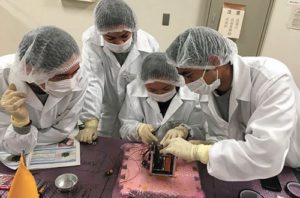
The tiny Himalayan Kingdom of Bhutan is to create its own space agency and will have its Bhutanese-built Cubesat – BHUTAN-1 – launched in 2018 from Japan.
Bhutanese Prime Minister Tshering Tobgay announced that a space agency is to be created under the auspices of the Ministry of Information and Communications. The nascent Bhutanese space programme is the result of a vision first promulgated by the King of Bhutan, H.M. Jigme Khesar Namgyel Wangchuck, ruler of Bhutan since 2006.
As part of that vision, Bhutanese engineers – with the help and cooperation of the Kyushu Institute of Technology in Japan – are building an Earth observation Cubesat called BHUTAN-1, which is nearing completion and due to be handed over to the Japanese Aerospace Exploration Agency (JAXA) in March 2018.
After that JAXA shall send BHUTAN-1 at an as yet unspecified date to the International Space Station (ISS) from where it shall be put into low-Earth orbit.
BHUTAN-1 is being assembled and tested at Kyushu Institute of Technology by four young Bhutanese engineers: Pooja Lepcha, Kiran Kumar Pradhan, Cheki Dorji, and Yeshey Choden.
BHUTAN-1 is being built as pasrt of the BIRDS-2 project sponsored by Japan, with engineers from the Philippines and Malaysia, as well as Bhutan, building Cubesats in Japanese universities that measure 10x10x10 centimeters each.
All of the BIRDS-2 Cubesats, including BHUTAN-1, are multipurpose systems that will have remote sensing, store-and-forward communications, as well as a number of scientific and technical features sensing and testing everything from the impact of radiation on Cubesats in low-Earth orbit through to Global Positioning System (GPS) device that measures the operation of low-power modules on the satellites.
“The major focus now is on the software of the satellite,” said Kiran Kumar Pradhan, referring to a final communications test being carried out to check the systems on BHUTAN-1.
Bhutanese engineer Cheki Dorji, commenting on Bhutan’s first foray into space, said, “Space involvement has always been associated with rich and developed countries and considered to be a far dream…But with the country’s first satellite in orbit, it would be proven that no dream is too big for anyone.”
“Once the satellite is in its orbit, we can do operations from the ground stations. The satellite can be used to relay data from remote hydro-meteorological stations to the data centre. For application missions, we expect to get an image of our country taken from around 400km in space,” Dorji added.
“The present satellite project focuses on capacity development for space science and technology hence, it will help bring the country’s focus towards space science and technology,” said Yeshey Choden. “Satellite technology has the potential to enhance socioeconomic development starting from agriculture to disaster response and natural resources management.”
Once put into orbit from the ISS, BHUTAN-1 will orbit Earth at an altitude of 500 to 1,500 kilometers and will take photographs of Bhutan with each pass it makes.
“What we achieve here is for the people and the country…[w]ith this project, we expect to make a mark of our country in this industry,” added Pradhan.


